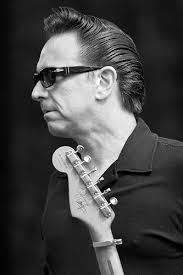
Jimmie Vaughan is one of our all time favorite guitar players. For us he defines the style of Texas blues with his passion for style, tone, timing, haircut, rhythm, everything! His music and unique playing style is recognized by a growing audience who has gotten tired of all the new fast playing blues rockers. You’ve heard many of those who plays fast and loud, have learned all the licks but just throw them around with no sense for timing. For Jimmie it’s all about less is more. A lot of great musicians have invited him to play on their albums and concerts. You owe yourself to listen to Jimmie’s guitar on John Lee Hooker’s Boom Boom on the album with the same name from 1992. Texas blues guitar meets Chicago blues at its very best.
His signature tone is recognizable in just a few notes. It is not just what you play, but what you don’t play. There are similarities to the style of T-Bone Walker where you need to stay away from hard bending, intense shaking, long notes, funky chords and jazz scales. Stick to the basics. Never try to sound like anyone else, just do what you’re supposed to do.
Amps
Jimmie’s amp tone in the early TBirds years 1970-1980 was not very unlike his younger brother’s. His tone then came from big, cranked blackface Fender amps. The early albums were recorded with Fender Bassman, Super Reverb among others.
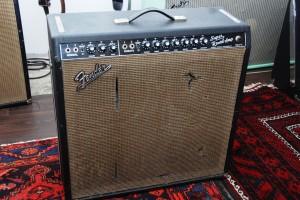
His tone, style and gear has evolved since his solo career started. It is fascinating how he reinvented himself on the Strange Pleasure album in ’94 with a whole new set of licks and style. His tone changed as well with more creamier distortion, non-Fender amps, capo, more fingers instead of flat pick and no reverb. He played his dual green Matchless amps a lot those years. Due to Jimmie’s playing style, involving mostly single strings and no pick, his tone appears to be clean and clear. But in fact there is a lot of tube amp distortion. You can hear it once he plays a chord involving several strings.
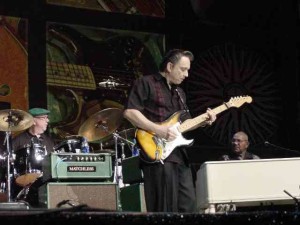
Around 2010 he changed direction of tone and style again with the two “Blues, Ballads & Favorites” albums together with Lou Ann Barton. The Grammatico Kingsville amps he used then are clean and natural sounding. No reverb. Mostly fingers here as well, but some flat pick in between. 10″ speakers give a typical scooped tone. Similar to a clean Tweed Bassman 4×10″ or a 90s Fender Vibro-King 3×10, both with Jensen or Eminence Alnico vintage-style speakers. This tone is not typical blackface/silverface tone. There is more bite and stinging sparkle on top.
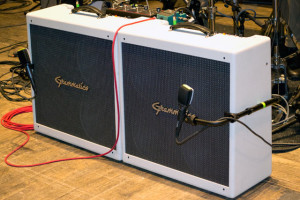
If you want to nail the early T-Birds JV tone you should seek amps with 10″ speaker configurations like Tweed Bassman, BF/SF Super Reverb, BF/SF Vibrolux, Vibro-King ++ with vintage style speakers, meaning low wattage, uncolored, smooth, warm, snappy and firm lows. A 50’s strat and a BF Vibrolux will take you there, for sure.
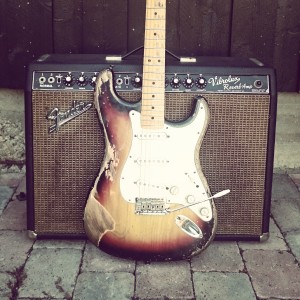
Low wattage 10s are very touch sensitive and dynamic, which is what you need when playing with your fingers with the guitar plugged right into the amp. You could aim for Jensen P10R, Eminence Legend Alnico, WGS Veteran ot vintage CTS or Jensens if you can find them. Jimmie’s tone require mostly that you push the amp hard into both power amp and preamp distortion.
If you’re into modification of Fender amps you may disable the negative feedback loop resulting in more power amp breakup and a rawer tone with highs and mids. It is also worth trying to lower the amp’s clean headroom, opposite to increasing it as for SRV’s tone. This can i.e. be done with 12AX7 phase inverter tube and higher impedance in speakers than in OT. Increasing the preamp gain by pulling V1 and disconnecting the tremolo circuit will also give you a thicker and creamier tone. Hot pickups are good since they push the preamp section hard, and as mentioned earlier you need to match the guitar to the amp and experiment with the EQ controls and bright switch.
Fingers
We’re not focusing on playing techniques on this site. However, this is essential when playing in the style of Jimmie Vaughan. Using a capo and fingers instead of a pick are main ingredients in his signature licks in later years. If you want to reproduce his tone you need to get the right hand right, positioning over pickups, pick attack etc. When using a pick, i.e.on a twelve bar shuffle in A or E, one should try to rest the right hand on the tremolo bridge while attacking the strings over the bridge pup. He often uses the middle or bridge pickup and rarely the neck pickup, but when he does he offers a serious sounding tone.
Here is a video demonstrating a texas shuffle inspired by Jimmie Vaughan:
